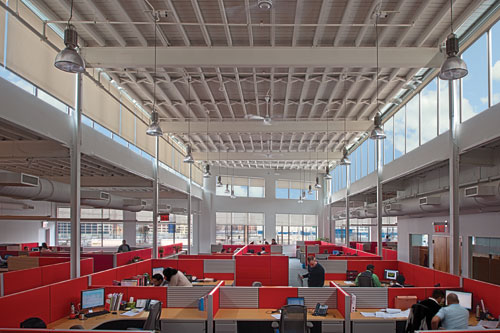Automated Shading and Light Systems
Select Systems with Solar Radiometers
The amount and type of daylight around a building at any given time is dependent upon three factors: the latitude of the building, the orientation of the building, and local weather conditions. However, not all automated shading systems are capable of taking advantage of the diffused daylight that is available when it's cloudy outside.
Many automated shading systems use an astronomic timeclock (ATC) to schedule the various positions of the shades throughout a day. An ATC schedules events in relationship to the position of the sun. For example, the shades on an east-facing window can be scheduled to deploy to the floor 15 minutes before sunrise, so they are in place to diffuse the direct early morning light. While an ATC is perfectly equipped to schedule shade positions to coordinate with the known solar path of the sun, it is unable to interpret local sky conditions and so it must control the shades as if every day is bright and sunny and potentially glare-creating.
Automatic shading systems that include solar radiometers, can determine if the day is sunny or cloud covered and modify shade position accordingly. On cloudy days, shades can be raised to let in the available daylight, when they may otherwise be found in the full-down position on a clear day. These radiometers enable a building to truly maximize daylight exposure by recognizing that there is no reason to further diffuse light that has already been diffused.
Specify DALI Ballasts for More Product Options
Ballasts that are individually addressable employ a communication protocol to receive signals from the central control panel. Many of the automated lighting control systems available today have closed and proprietary systems, meaning that the central control panel distributes signals that can only be interpreted by the same brand of ballast and those ballasts can only interpret the signals sent from their specific lighting control panel. These systems can trap specifiers into buying the entire lighting and lighting control system from one manufacturer and this can severely limit the number of compatible products available, which can impact design freedom. Other lighting control panels are termed independent or ballast neutral, meaning that the central unit does not employ a proprietary communication protocol and can communicate with any number of dimmable ballasts on the market. DALI is one such type of universal communication protocol.
Today, automated shading and lighting control systems offer the dynamic control necessary to best manage the ever-changing presence of daylight in a building, in the automated solution that minimizes the amount of time building occupants must spend controlling their lights. It lowers shades to keep direct sunlight out. It raises shades to maximize the available views and ambient daylight allowed in. It dims the electric lights, when daylight is present. It raises electric light levels, when daylight is not present and it does it all automatically. In fact, it's doing it right now.
| Conversion of Factory Building to Office Space Yields LEED GOLD and Exceeds
Sustainability Goals | ||
Over the last four years, in Long Island City, New York, contractors have been transforming a 46,000-square-foot, 100 year-old factory into a certified LEED Gold company headquarters, enhancing the original design with the latest automated building systems. Water conserving fixtures, photovoltaics, HVAC systems, eco-friendly office interiors, and replacement façade windows with 1-inch insulate glass and low-e coating have all been incorporated, but it has been the automated shading and lighting control system that has had the greatest impact improving occupant experience, saving energy, and realizing the full potential of the original design's intent to maximize the daylight in the workspace. The factory is a perfect example of an early 1900s building where the architect gave great consideration to siting and orientation in order to optimize the interaction between daylight and the interior. The north wall is predominately dressed in glass and clerestory windows run east and west above the factory floor. Converting this factory into a single-tenant office space for 200, management wanted to take full advantage of all of the windows designed by the first architects and even restored windows that had been eliminated during previous renovations. With an automated shading system, windows can be added to an envelope, without exposing the interior to direct solar radiation or glare. Scheduled to accommodate the known solar path of the sun, the shades will lower automatically when the sun is positioned in such a way that direct sunlight would penetrate the space. The woven fabric of the solar shades diffuses the direct light eliminating potential glare. When the sun’s position changes, the shades raise automatically, filling the space with ambient daylight and unobstructed views of the outdoors. This renovation required more than better management of daylight to achieve LEED Gold status. The energy efficiency of the factory had to be improved. The automated shading and lighting control systems have generated considerable savings for both lighting and HVAC systems. When daylight is detected in the interior, the electric lights dim or switch off. Many days, the electric lights around the perimeter of the building and under the clerestory windows are not on until the sun goes down. Today, this sturdy, industrial building in an urban setting is occupied and operational. The project has achieved a LEED Gold certification and consumes about 25 percent less energy than its baseline design. The automated shading and lighting control systems continue to actively manage the light levels in the building. |
 |
MechoSystems is the world's leading designer and manufacturer of manual, motorized, and automated solar-shading systems for the architectural and design communities. The company provides contemporary WindowManagement® solutions for today's design challenges. Products are designed to meet the challenges of sustainability, WindowManagement®, and effective daylighting. To contact representatives and distributors worldwide, visit: MechoSystems.com/automation |









